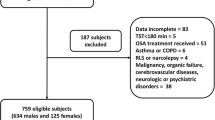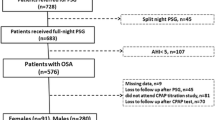Abstract
Purpose
Different authors have reported that aging could be associated with changes in obstructive sleep apnea (OSA) related parameters (apnea/hypopnea index, SpO2, reduction of daytime sleepiness, etc.), type of sleep and pattern of collapse. Regarding OSA severity in elderly patients, it is commonly believed that the AHI score tends to increase with aging.
Methods
In this paper, we reviewed the literature regarding the studies which compared older (> 65 years old) and young (< 65 years old) OSA patients regarding the effect of aging on daytime sleepiness (ESS evaluation) and OSA severity (AHI evaluation). A meta-analysis to evaluate the effect of age on daytime sleepiness and OSAS severity was also performed to corroborate previously reported experience.
Results
Meta-analysis showed no statistical (p = 0.8) differences regarding AHI differences emerged from the comparison of the two groups of patients. Elderly patients (> 65 years old) showed less daytime sleepiness, showing a statistical difference in the meta-analysis of data (p = 0.004)
Conclusion
Although a direct correlation between aging and AHI values would seem to be present, no significant differences in baseline AHI between young (< 65-years-old) and elderly (> 65-years-old) patients emerged in this meta-analysis study. The effects of OSAS on daytime sleepiness seem to be much more prominent in young or middle-aged patients than in elderly patients.





Similar content being viewed by others
References
Bosi M, De Vito A, Gobbi R et al (2017) The importance of obstructive sleep apnoea and hypopnea pathophysiology for customized therapy. Eur Arch Otorhinolaryngol 274:1251
Hora F, Napolis LM, Daltro C et al (2007) Clinical, anthropometric and upper airway anatomic characteristics of obese patients with obstructive sleep apnea syndrome. Respiration 74:517–524
Leppänen T, Töyräs J, Mervaala E, Penzel T, Kulkas A (2017) Severity of individual obstruction events increases with age in patients with obstructive sleep apnea. Sleep Med 37:32–37
Iannella G, Vicini C, Polimeni A, Greco A, Gobbi R, Montevecchi F et al (2019) Laryngopharyngeal reflux diagnosis in obstructive sleep apnea patients using the pepsin salivary test. Int J Environ Res Public Health 10:16
Magliulo G, Iannella G, Ciofalo A, Polimeni A, De Vincentiis M, Pasquariello B, Montevecchi F, Vicini C (2019) Nasal pathologies in patients with obstructive sleep apnoea. Acta Otorhinolaryngol Ital. https://doi.org/10.14639/0392-100X-2173
Viner S, Szalai JP, Roffstein V (1991) Are history and physical examination a good screening test for sleep apnea? Ann Int Med 115:356–359
Ancoli-Israel S, Kripke DF, Klauber MR, Mason WJ, Fell R, Kaplan O (1991) Sleep-disordered breathing in community-dwelling elderly. Sleep 14:486–495
Enright PL, Newman AB, Wahl PW et al (1996) Prevalence and correlates of snoring and observed apneas in 5201 older adults. Sleep 19:531–538
Endeshaw Y (2015) Clinical characteristics of obstructive sleep apnea in community‐dwelling older adults. J Am Geriatr Soc 54:1740–1744
Quintana-Gallego E, Carmona-Bernal C, Capote G et al (2004) Gender differences in obstructive sleep apnea: a clinical study of 1166 patients. Respir Med 98:984–989
Young T, Shahar E, Nieto FJ et al (2002) Predictors of sleep-disordered breathing in community-dwelling adults: the sleep heart health study. Arch Intern Med 162:893–900
Somers VK, White DP, Amin R et al (2008) Sleep apnea and cardiovascular disease: an American Heart Association/American College of Cardiology Foundation scientific statement from the American Heart Association Council for High Blood Pressure Research Professional Education Committee, Council on Clinical Cardiology, Stroke Council, and Council on Cardiovascular Nursing. J Am Coll Cardiol 52:686–717
Peppard PE, Young T, Palta M et al (2000) Prospective study of the association between sleep-disordered breathing and hypertension. N Engl J Med 342:1378–1384
Yaffe K, Laffan AM, Harrison SL et al (2011) Sleep-disordered breathing, hypoxia, and risk of mild cognitive impairment and dementia in older women. JAMA 306:613–619
Baldwin CM, Griffith KA, Nieto FJ et al (2001) The association of sleep-disordered breathing and sleep symptoms with quality of life in the Sleep Heart Health Study. Sleep 24:96–105
Marshall NS, Wong KK, Liu PY et al (2008) Sleep apnea as an independent risk factor for all-cause mortality: the Busselton Health Study. Sleep 31:1079–1085
Netzer NC, Stoohs RA, Netzer CM et al (1999) Using the Berlin Questionnaire to identify patients at risk for the sleep apnea syndrome. Ann Intern Med 131:485–491
Chung F, Yegneswaran B, Liao P et al (2008) STOP questionnaire: a tool to screen patients for obstructive sleep apnea. Anesthesiology 108:812–821
Chung F, Elsaid H (2009) Screening for obstructive sleep apnea before surgery: why is it important? Curr Opin Anaesthesiol 22:405–411
Takegami M, Hashino Y, Chin K, Sokejima S, Kodtani H (2009) Simple four-variable screening tool for identification of patients with sleep-disordered breathing. Sleep 32:939–948
Johns MW (1991) A new method for measuring daytime sleepiness: the Epworth sleepiness scale. Sleep 14:540–545
Chung S, Yoon IY, Lee CH et al (2009) Effects of age on the clinical features of men with obstructive sleep apnea syndrome. Respiration 78:23–29
George E, Katerina V, Maria S, Lambros B, Konstantina N, Dimitrios G (2012) Clinical features and polysomnographic findings in greek male patients with obstructive sleep apnea syndrome: differences regarding the age. Sleep Disord 2012:324635
Edwards BA, Wellman A, Sands SA, Owens RL, Eckert DJ, White DP, Malhotra A (2014) Obstructive sleep apnea in older adults is a distinctly different physiological phenotype. Sleep 37:1227–1236
Hongyo K, Ito N, Yamamoto K, Yasunobe Y, Takeda M, Oguro R, Takami Y, Takeya Y, Sugimoto K, Rakugi H (2017) Factors associated with the severity of obstructive sleep apnea in older adults. Geriatr Gerontol Int 17:614–621
Zhao C, Viana A Jr, Ma Y, Capasso R (2018) The effect of aging on drug‐induced sleep endoscopy findings. Laryngoscope 128:10
Vicini C, De Vito A, Iannella G et al (2018) The aging effect on upper airways collapse of patients with obstructive sleep apnea syndrome. Eur Arch Otorhinolaryngol 275:2983
Morrell MJ, Finn L, McMillan A, Peppard PE (2012) The impact of ageing and sex on the association between sleepiness and sleep disordered breathing. Eur Respir J 40:386–393
Peppard PE, Young T, Barnet JH, Palta M, Hagen EW, Hla KM (2013) Increased prevalence of sleep-disordered breathing in adults. Am J Epidemiol 177:1006–1014
Hoch CC, Dew MA, Reynolds CF, Buysse DJ, Nowell PD, Monk TH, Mazumdar S, Borland MD, Miewald J, Kupfer DJ (1997) Longitudinal changes in diary- and laboratory-based sleep measures in healthy "old old" and "young old" subjects: a three-year follow-up. Sleep 20:192–202
Ancoli-Israel S, Gehrman P, Kripke DF, Stepnowsky C, Mason W, Cohen Zion M et al (2001) Longterm follow-up of sleep disordered breathing in older adults. Sleep Med 2:511–516
Iannella G, Magliulo G, Montevecchi F, De Vito A, Polimeni A, De Vincentiis M et al (2018) Lingual tonsil lymphatic tissue regrowth in patients undergoing transoral robotic surgery. Laryngoscope. https://doi.org/10.1002/lary.27775
Sforza E, Roche F, Thomas-Anterion C et al (2010) Cognitive function and sleep related breathing disorders in a healthy elderly population: the SYNAPSE study. Sleep 33:515–521
Malhotra A, Huang Y, Fogel R et al (2006) Aging influences on pharyngeal anatomy and physiology: the predisposition to pharyngeal collapse. Am J Med 119:72
Kollias I, Krogstad O (1999) Adult craniocervical and pharyngeal changes—a longitudinal cephalometric study between 22 and 42 years of age. Part I: morphological craniocervical and hyoid bone changes. Eur J Orthod 21:333–344
Erskine RJ, Murphy PJ, Langton JA et al (1993) Effect of age on the sensitivity of upper airway reflexes. Br J Anaesth 70:574–575
Magliulo G, Iannella G, Polimeni A, De Vincentiis M, Meccariello G, Gulotta G et al (2018) Laryngopharyngeal reflux in obstructive sleep apnoea patients: literature review and meta-analysis. Am J Otolaryngol 39:776–780
Redline S, Schluchter MD, Larkin EK, Tishler PV (2003) Predictors of longitudinal change in sleep disordered breathing in a nonclinic population. Sleep 26:703–709
Gottlieb DJ, Whitney CW, Bonekat WH, Iber C, James GD, Lebowitz M, Nieto FJ, Rosenberg CE (1999) Eelation of sleepiness to respiratory disturbance index: the Sleep Heart Health Study. Am J Respir Crit Care Med 159:502–507
Funding
None.
Author information
Authors and Affiliations
Corresponding author
Ethics declarations
Conflict of interest
The authors declare that they have no conflict of interest.
Ethical approval
All procedures performed in studies were in accordance with the ethical standards of the institutional committee of the Morgagni Pierantoni Hospital and with the 1964 Helsinki declaration.
Informed consent
Informed consent was obtained from all individual participants included in the study.
Additional information
Publisher's Note
Springer Nature remains neutral with regard to jurisdictional claims in published maps and institutional affiliations.
This article is part of the Topical Collection on sleep apnea syndrome. Guest Editors: Manuele Casale, Rinaldi Vittorio.
Rights and permissions
About this article
Cite this article
Iannella, G., Vicini, C., Colizza, A. et al. Aging effect on sleepiness and apneas severity in patients with obstructive sleep apnea syndrome: a meta-analysis study. Eur Arch Otorhinolaryngol 276, 3549–3556 (2019). https://doi.org/10.1007/s00405-019-05616-0
Received:
Accepted:
Published:
Issue Date:
DOI: https://doi.org/10.1007/s00405-019-05616-0




